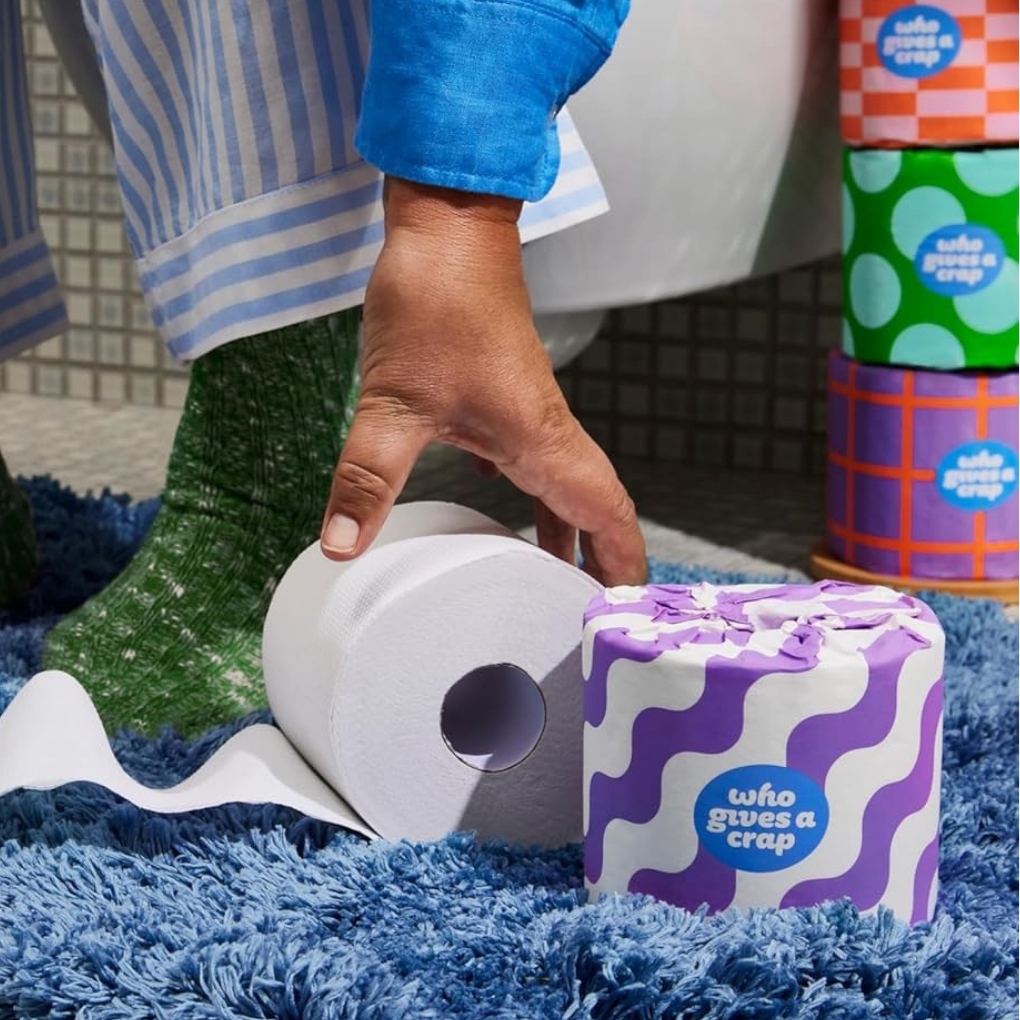
Key Takeaways
- Chlorine-free toilet paper avoids harsh chemicals like dioxins, making it gentler on skin.
- Using chlorine-free products reduces water pollution and protects ecosystems.
- Look for TCF, PCF, or ECF labels to ensure your toilet paper is truly chlorine-free.
Toilet paper is something we all use every day, but most of us don’t stop to think about it; we just grab a pack at the store. The thing is, not all toilet paper is the same. Many popular brands are bleached with chlorine and may contain additional chemicals that aren’t beneficial to our bodies or the environment.
As more people start paying attention to what’s really in the products they use at home, a new question comes up: What’s actually in my toilet paper? That’s where chlorine-free toilet paper comes in. In this guide, we’ll explain what chlorine-free toilet paper actually is, why it matters, and how to find rolls that are gentler on your behind and kinder to the planet.
What is Chlorine-Free Toilet Paper?
“Chlorine-free” toilet paper means it hasn’t been whitened with chlorine gas, which is the old-school method most big brands use. That process makes the paper bright white, but it also creates harmful leftovers called byproducts.
Here are a few terms you might see on packaging:
- ECF (Elemental Chlorine Free): Uses chlorine dioxide instead of chlorine gas. It’s a bit safer but still not perfect.
- TCF (Totally Chlorine Free): Uses alternatives like oxygen, ozone, or hydrogen peroxide instead of chlorine. This is the cleanest option.
- Unbleached: No bleaching at all, so the paper stays its natural beige or tan color.
🔍 Look for: Labels that say “TCF” or “unbleached” if you want the safest chlorine-free choices.
Reasons to Avoid Chlorine in Toilet Paper
Health Impacts
When toilet paper is bleached with chlorine, it can leave behind tiny amounts of chemicals called dioxins. These are harmful compounds that have been linked to things like hormone problems, reproductive issues, and even a higher risk of cancer. Although the amounts are small, dioxins can accumulate in your body over time. Chlorine bleaching can also irritate people with sensitive skin, sometimes causing rashes or other skin irritations.
Environmental Impacts
Chlorine doesn’t just affect people; it also harms the environment. The bleaching process generates pollution that is washed into rivers, lakes, and oceans. This pollution can harm fish, wildlife, and entire ecosystems, exacerbating the problem of water pollution and disrupting the balance of nature.
📚 According to the U.S. Environmental Protection Agency, chlorine bleaching in the paper industry is one of the primary sources of dioxins in the environment — toxic chemicals that build up over time and can harm people, wildlife, and entire ecosystems.
Harmful Chemicals Can Be Found in Toilet Paper
Toilet paper can contain harmful additives like PFAS, BPA, formaldehyde, and synthetic fragrances, which the U.S. Environmental Protection Agency (EPA) and other health organizations have linked to hormone disruption, skin irritation, and long-lasting environmental pollution.
Here are a few to keep an eye out for:
- PFAS (“forever chemicals”) – Linked to hormone problems and known for sticking around in the environment for decades.
- BPA – Sometimes found in recycled papers that weren’t carefully processed.
- Formaldehyde – Added by some brands to make the paper stronger, but it’s a known skin irritant.
- Synthetic fragrances or dyes – These don’t make toilet paper work any better, but they can cause allergic reactions or irritation.
Choosing a truly non-toxic toilet paper helps you avoid these hidden extras, along with chlorine, giving you a safer and cleaner option for everyday use.
Don’t Miss: How to Tell If Plastic Is BPA-Free Not sure how to spot BPA-free plastic? Find out the simple signs right here. Read more →Does Toilet Paper Contain Microplastics?
Surprisingly, yes. Research has shown that toilet paper can be a hidden source of microplastics, even when it looks “natural” or eco-friendly on the surface.
What the research shows
- A recent preprint by Trinh & Trinh explores microplastic concentrations in toilet paper under lab conditions, highlighting that this everyday product can be a hidden source of microplastics.
- Likely sources include:
- Recycled paper fibers that already contain microplastic residues.
- Synthetic additives or coatings used in the manufacturing process.
- Contamination during processing — even “virgin fiber” toilet paper wasn’t immune.
ℹ️ I want to be clear that even recycled toilet paper may contain microplastics. I’ve included brands with recycled options here because they are chlorine-free, but that doesn’t mean they are microplastic-free.
What Are the Benefits of Chlorine-Free Toilet Paper?
Switching to chlorine-free toilet paper may seem like a minor change, but it can make a significant difference for both your health and the environment. Here’s why:
💚Healthier for your body – Without chlorine, dioxins, or harsh chemicals, you’re avoiding things that can build up in your system or irritate your skin.
🌸Gentler on sensitive skin – Chlorine-free rolls are typically fragrance-free and hypoallergenic, making them suitable for individuals with allergies or skin sensitivities.
🌍Better for the planet – No chlorine bleaching means less water pollution, and many brands pair this with eco-friendly practices like using recycled or bamboo fibers.
🌱Extra sustainable features – A lot of chlorine-free brands also come in plastic-free packaging or support reforestation programs, so your choice stretches even further.
By choosing chlorine-free, you’re not only taking care of yourself but also making a positive impact on the world around you.
Types of Chlorine-Free Toilet Paper
Not all chlorine-free toilet paper is the same. The good news is there are a few different kinds to choose from, depending on what matters most to you — softness, price, or sustainability.
- Bamboo toilet paper – Bamboo grows super fast and doesn’t need as many resources as trees, which makes it a renewable choice. It’s usually soft, firm, and a favorite for people who want a more “luxury” feel without harsh chemicals.
- Recycled toilet paper – Made from post-consumer waste (like office paper), this option helps keep paper out of landfills. It’s often the most eco-friendly choice, though it can feel a little rougher than bamboo. Look for BPA-free labeling.
- Unbleached paper – This is toilet paper in its most natural state, with no bleaching at all. It may look tan or beige instead of bright white, but that’s a good sign — it means fewer chemicals.
🔍 Look for: Labels that say bamboo, 100% recycled, or unbleached when you’re shopping. Each option has its own benefits, but they’re all safer than chlorine-bleached rolls.
Top 11 Chlorine-Free Toilet Paper Brands Reviewed
If you’ve ever stood in the toilet paper aisle (or scrolled online) wondering which brands are actually chlorine-free and eco-friendly, you’re not alone. To make it easier, we’ve rounded up 11 of the top chlorine-free toilet paper brands.
Each one has its own strengths, from the softness of bamboo to recycled rolls that reduce waste, and many come with trusted certifications to prove they’re the real deal.
Grove Co.
$5 – 8 rolls
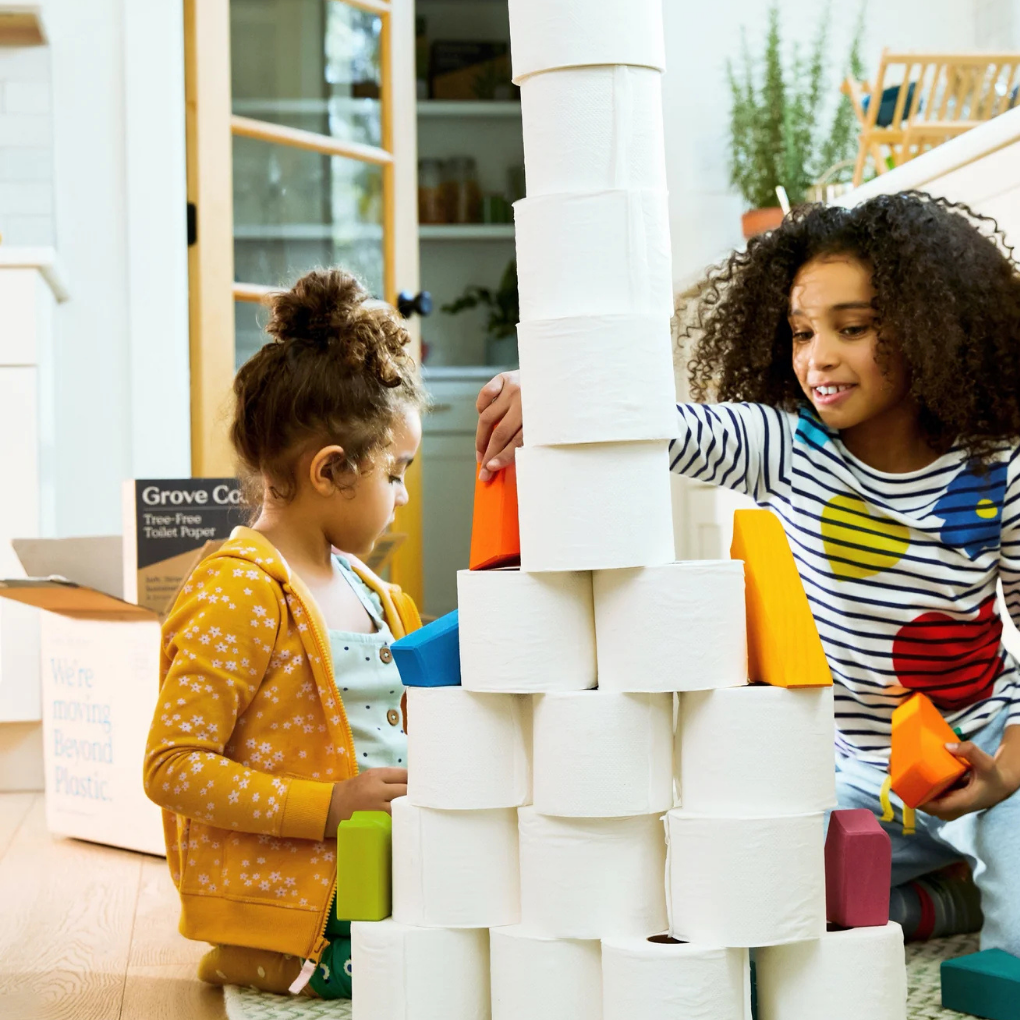
Grove Co. has built a reputation for eco-friendly household products, and their Tree-Free Toilet Paper is no exception. Instead of using trees, Grove makes its rolls from 100% FSC-certified bamboo, which grows quickly and is a renewable resource. That means you get a strong, soft roll without contributing to deforestation.
Each roll is chlorine-free, fragrance-free, and dye-free, ensuring you’re not using unnecessary chemicals. It’s also septic-safe and biodegradable, making it a good choice for most households. The paper itself feels closer to premium bamboo brands — soft but sturdy, with 3-ply strength.
Packaging is another win: Grove ships their toilet paper in plastic-free, recyclable cardboard boxes, keeping extra waste out of landfills. And because Grove Co. is a Certified B Corporation, you know they meet third-party standards for social and environmental responsibility.
- Certifications: FSC® (bamboo), Certified B Corporation
Aria
$10 – 12 rolls

Aria is a toilet paper brand that tries to balance comfort with eco-friendly practices. Instead of being made from bamboo or fully recycled fibers, like some other brands, Aria uses a mix of responsibly sourced materials and backs it up with certification. Their rolls are FSC®-recycled certified, which means the paper comes from recycled sources that meet strict environmental standards.
Aria’s toilet paper is also known for being thicker and softer than many eco-brands, so if you’re used to the plush feel of mainstream toilet paper, this one can be an easier switch. It’s septic-safe and biodegradable, making it safe for most plumbing systems.
While Aria may not go quite as far with bold sustainability initiatives (such as planting trees or carbon-neutral shipping), it’s widely available in stores. It offers a solid middle ground between mainstream comfort and eco-conscious responsibility.
- Certifications: FSC®-recycled
Caboo
$12 – 12 rolls
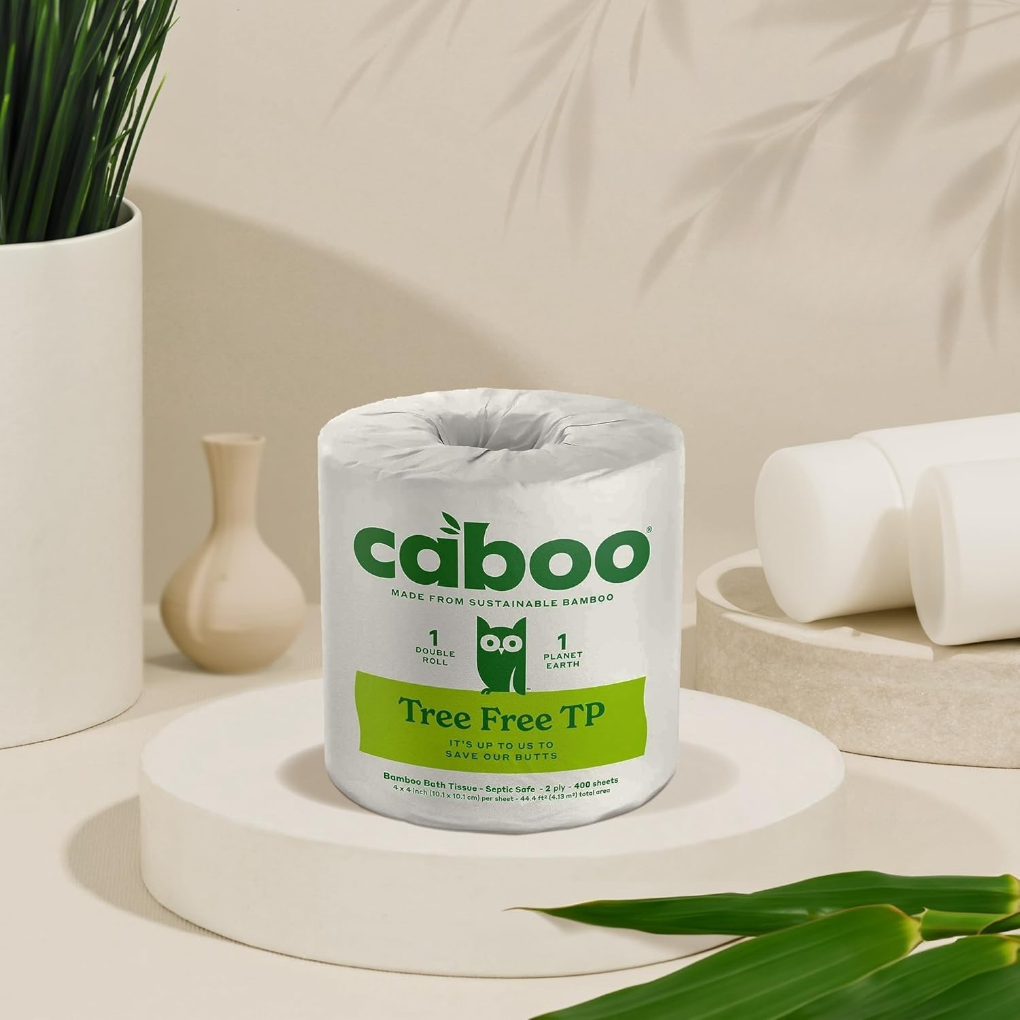
Caboo is a brand that takes a slightly different approach by using both bamboo and sugarcane bagasse (a byproduct from sugarcane processing) to make its toilet paper. Both materials are fast-growing and renewable, which means no old-growth forests are cut down in the process. Their rolls are FSC-certified, indicating that the bamboo and sugarcane come from responsibly managed sources.
Caboo’s toilet paper is chlorine-free, septic-safe, and biodegradable, making it a good choice for homes with sensitive plumbing or septic systems. It’s also free from fragrances, inks, and dyes, so it’s gentler on your skin compared to many conventional brands.
In terms of texture, Caboo falls somewhere between recycled and bamboo-only rolls — it’s softer than recycled but not quite as plush as premium bamboo brands. Still, it’s sturdy, strong, and eco-friendly.
- Certifications: FSC® (bamboo & sugarcane bagasse)
Seventh Generation
$12 – 12 rolls
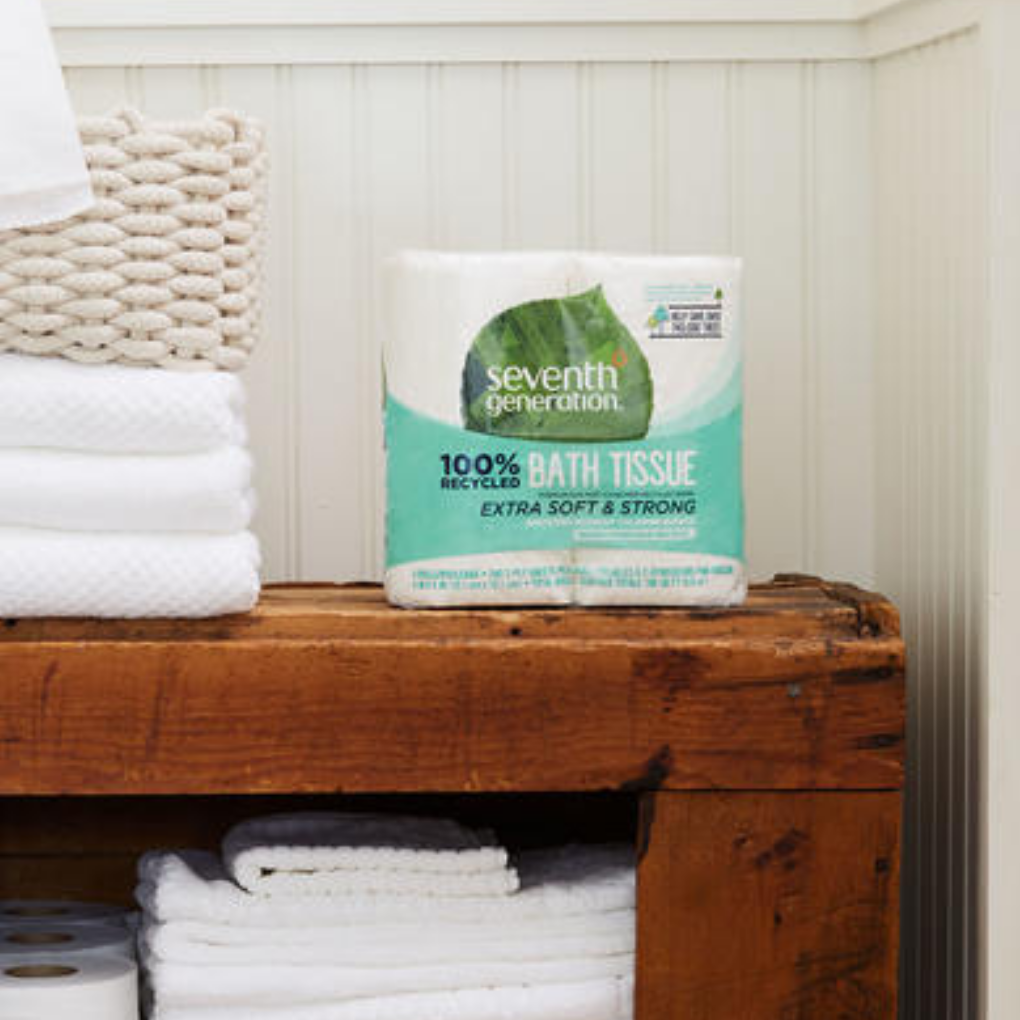
Seventh Generation is one of the most recognizable eco-friendly brands in the U.S., and their toilet paper is no exception. Unlike many mainstream rolls, it’s made from 100% recycled paper and comes with FSC® Recycled certification, which means the paper is responsibly sourced and meets strict environmental standards.
What you’ll notice right away is that their rolls aren’t bleached bright white; they’re chlorine-free and unbleached, so the paper looks a little more natural. That’s actually a good thing, since it means fewer harsh chemicals.
Seventh Generation is also widely available in major grocery stores, making it one of the easiest eco-friendly toilet paper brands to find. While the texture may feel slightly rougher than that of bamboo options, it remains durable, septic-safe, and biodegradable.
- Certifications: FSC® Recycled
Who Gives a Crap
$23 – 8 rolls

How can you not laugh a little at the name Who Gives A Crap? It’s cheeky, sure—but this brand is seriously committed to sustainability, with bamboo and recycled rolls, B Corp certification, and 50% of profits donated to sanitation projects.
The brand began in 2012 in Melbourne, Australia, with one of the most unusual crowdfunding campaigns ever — co-founder Simon Griffiths sat on a toilet for 50 hours straight until they raised enough money to launch.
They sell two main types of chlorine-free toilet paper: 100% recycled rolls and bamboo rolls. The recycled rolls are made from used paper that would otherwise end up in landfills, which helps save trees.
They’re strong and eco-friendly, but they can feel a little rougher than the big supermarket brands. The bamboo rolls are softer and sturdier, making them the choice if comfort is important to you. Additionally, the bamboo is FSC-certified, ensuring it’s grown and harvested responsibly.
Another notable aspect of this brand is its packaging. Instead of plastic, every roll is wrapped in colorful, recyclable paper that looks fun and is easy on the planet. Additionally, Who Gives A Crap is a Certified B Corporation, which means it meets high standards for social and environmental responsibility.
But what really sets them apart is their mission: they donate 50% of their profits to building toilets and improving sanitation in communities that need it most. So when you buy from Who Gives A Crap, you’re not just stocking up on toilet paper — you’re also helping create cleaner, healthier lives around the world.
- Certifications: FSC® (bamboo), Certified B Corporation
Bim Bam Boo
$25 – 12 rolls
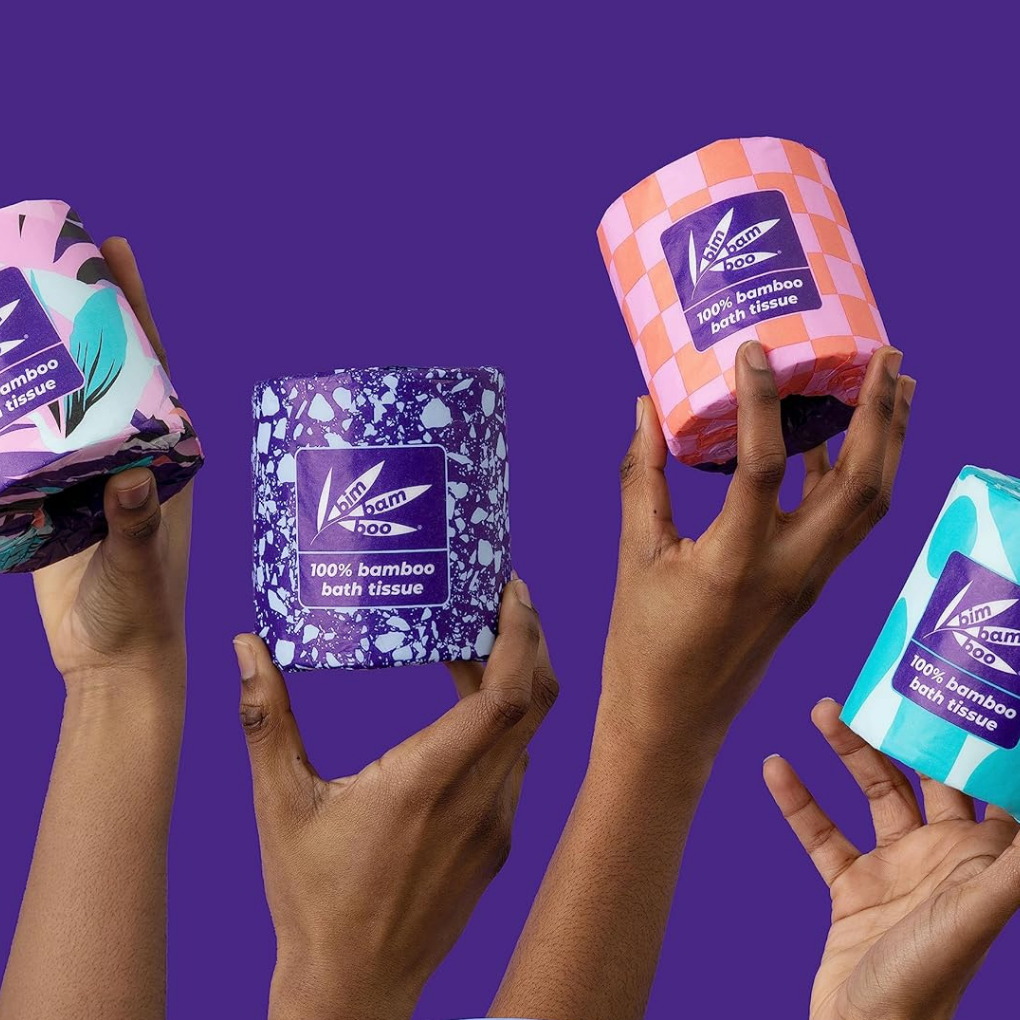
If you’ve got sensitive skin, Bim Bam Boo might be the brand for you. Their toilet paper is made from FSC-certified bamboo and is free from chlorine, dyes, fragrances, and other harsh chemicals. It’s also dermatologist-tested and marketed as hypoallergenic, making it a good choice for individuals who experience irritation from regular toilet paper.
One thing that sets Bim Bam Boo apart is its list of certifications. Besides FSC®, it’s also USDA BioPreferred, meaning it’s made from renewable resources, and it carries ECF (Elemental Chlorine Free) and ISO 9001 standards. That’s a significant amount of evidence that the brand prioritizes health and sustainability.
In terms of feel, Bim Bam Boo is softer than recycled paper and holds up well compared to traditional rolls. Like many bamboo brands, it’s septic-safe and biodegradable.
- Certifications: FSC®, USDA BioPreferred, ECF, ISO 9001
Ollie & Vince
$28 – 24 rolls
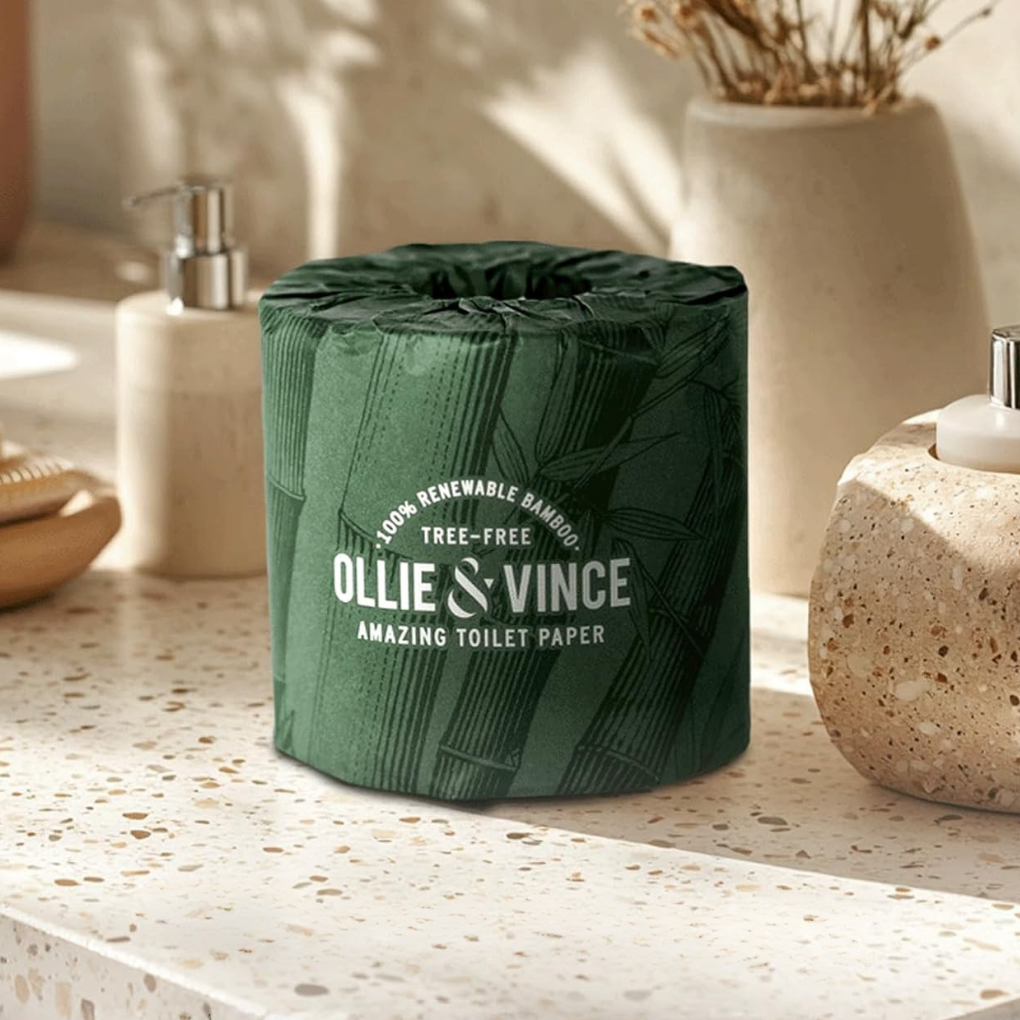
Ollie & Vince is a premium toilet paper brand with a serious eco-friendly mission. Their rolls are made from 100% FSC-certified bamboo, providing you with softness and strength without cutting down trees. Each roll is wrapped in colorful, recyclable paper instead of plastic, which makes the packaging both stylish and sustainable.
What sets Ollie & Vince apart is the number of certifications they’ve earned. They’re PeTA certified cruelty-free, USDA BioPreferred, a member of 1% for the Planet, and partner with One Tree Planted to reforest areas around the world. Additionally, they’re Plastic Negative, which means they remove more plastic from the environment than they use. That’s a big step beyond just being plastic-free.
Their toilet paper is 3-ply, chlorine-free, and fragrance-free, making it gentle on the skin while still being strong and septic-safe. It feels closer to luxury rolls you’d find at the store, but with the bonus of being planet-friendly.
- Certifications: FSC®, PeTA, USDA BioPreferred, 1% for the Planet, One Tree Planted, Plastic Negative
Reel
$28 – 12 rolls

Reel is one of the big names in sustainable toilet paper, and it’s easy to see why. The company produces its rolls from 100% FSC-certified bamboo, which means the bamboo originates from responsibly managed farms that protect forests and ecosystems. No chlorine, inks, or dyes are used, so it’s a safer choice for both people and the planet.
One thing that makes Reel stand out is its packaging; everything comes in plastic-free, recyclable wrapping. They also keep their footprint lower by offering subscription delivery, which helps reduce the number of extra trips to the store and minimizes packaging waste.
Reel doesn’t stop there, though. The company also invests in reforestation programs and supports projects that bring clean sanitation to communities in need. Their rolls are septic-safe and biodegradable, so they work in most homes without worry.
- Certifications: FSC® (bamboo)
Betterway
$29 – 12 rolls
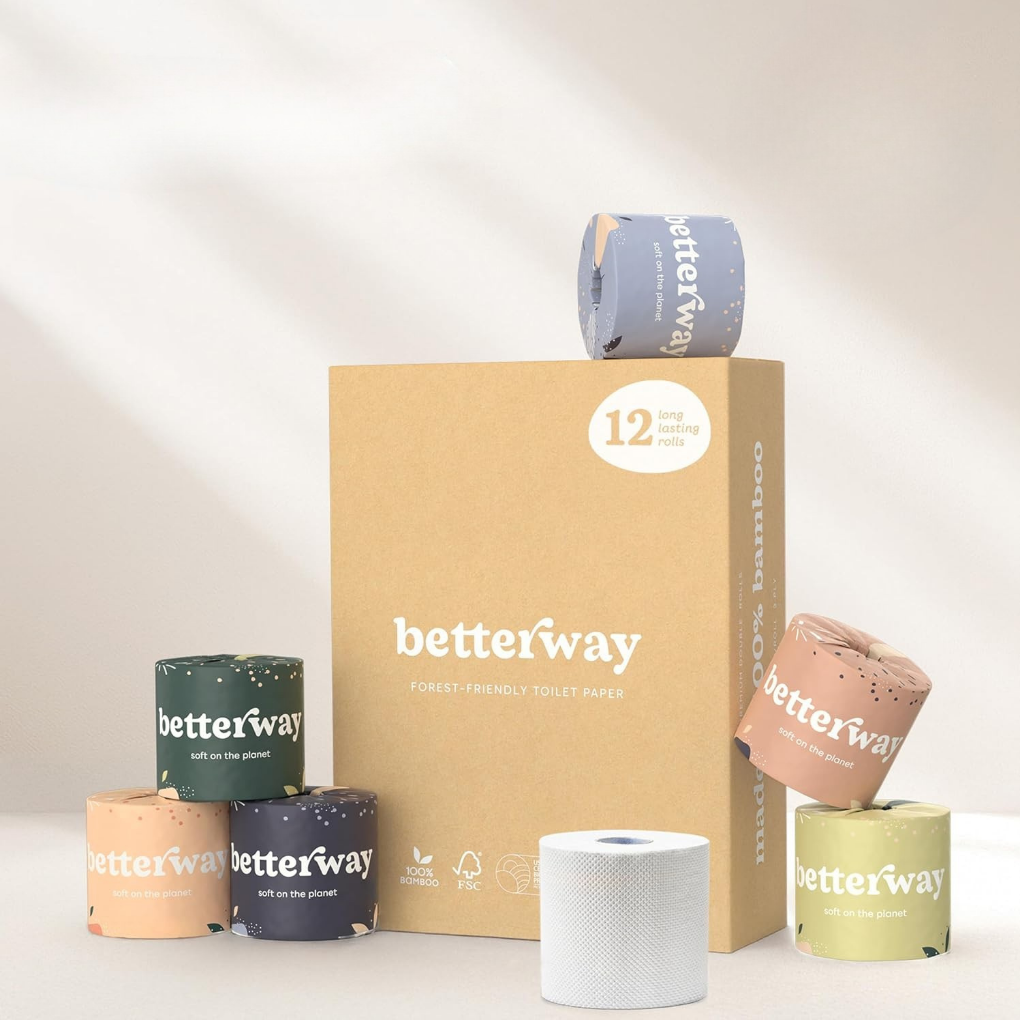
Betterway is a bamboo toilet paper brand that focuses on providing you with softness without the use of chemicals. Their rolls are made from FSC-certified bamboo, ensuring the bamboo is grown responsibly and harvested in a manner that protects forests and ecosystems.
What people like about Betterway is how soft and thick it feels, closer to the premium rolls you’d find in a grocery store. It’s 3-ply, strong, and still breaks down easily in water, which makes it septic-safe and eco-friendly. Betterway is also chlorine-free and doesn’t use dyes, fragrances, or other unnecessary additives, so it’s gentler on sensitive skin.
Another nice detail is the plastic-free packaging. Rolls come wrapped in recyclable paper instead of plastic, which helps reduce waste.
- Certifications: FSC® (bamboo)
Save Trees
$34 – 12 rolls
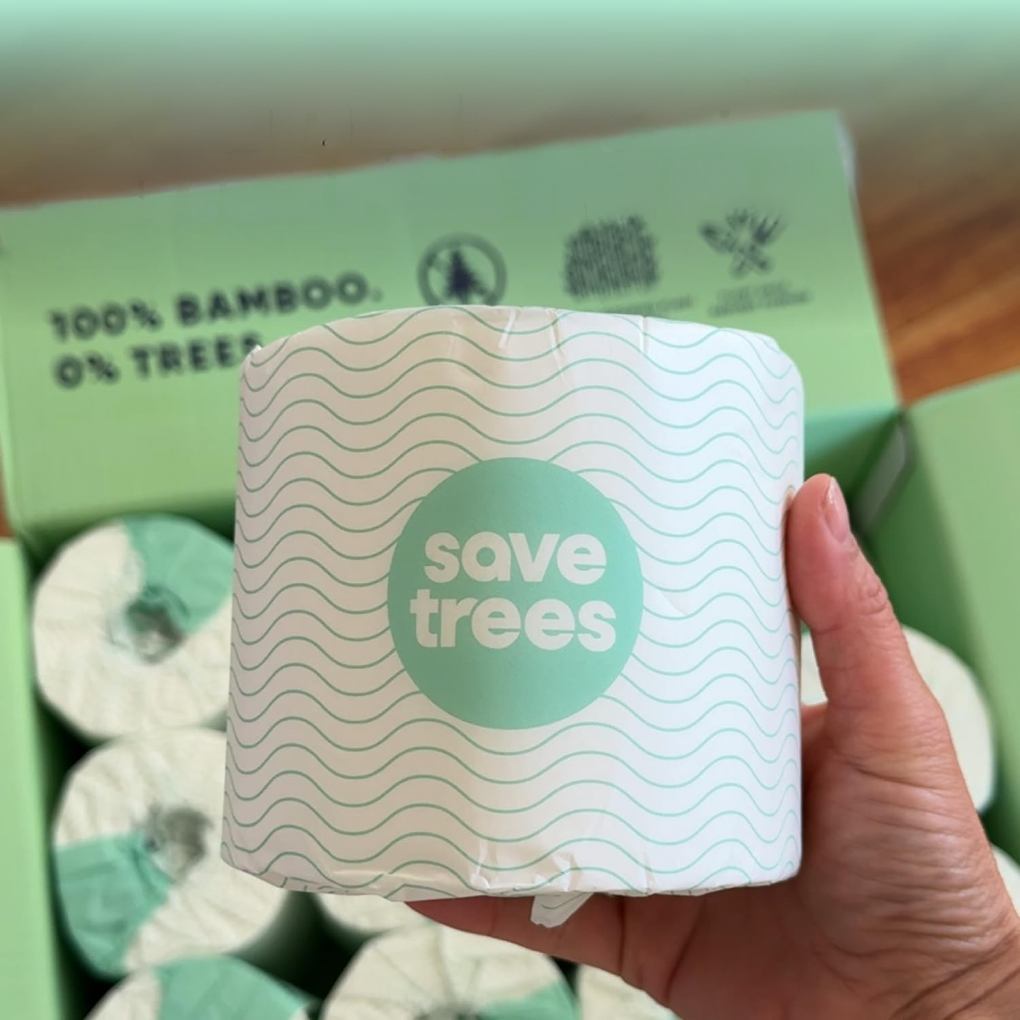
The name says it all — Save Trees makes toilet paper that’s designed to protect forests while still giving you a soft, reliable roll. Instead of cutting down trees, they use FSC®-certified bamboo, which grows super fast and doesn’t require replanting. That means less deforestation and a much smaller footprint.
Their toilet paper is made without chlorine, PFAS, or other harsh chemicals, so it’s safer for your skin and the environment. Each roll is 3-ply, with approximately 300 sheets, so you get the strength and softness without feeling like you’re giving anything up.
Another win? Plastic-free packaging and carbon-neutral shipping. Save Trees takes it a step further by planting trees; they’ll plant one for every customer review and five for every referral. It’s their way of giving back and making sure your bathroom habits have a positive impact.
- Certifications: FSC® (bamboo)
Uranus Wiper
$50 – 48 rolls
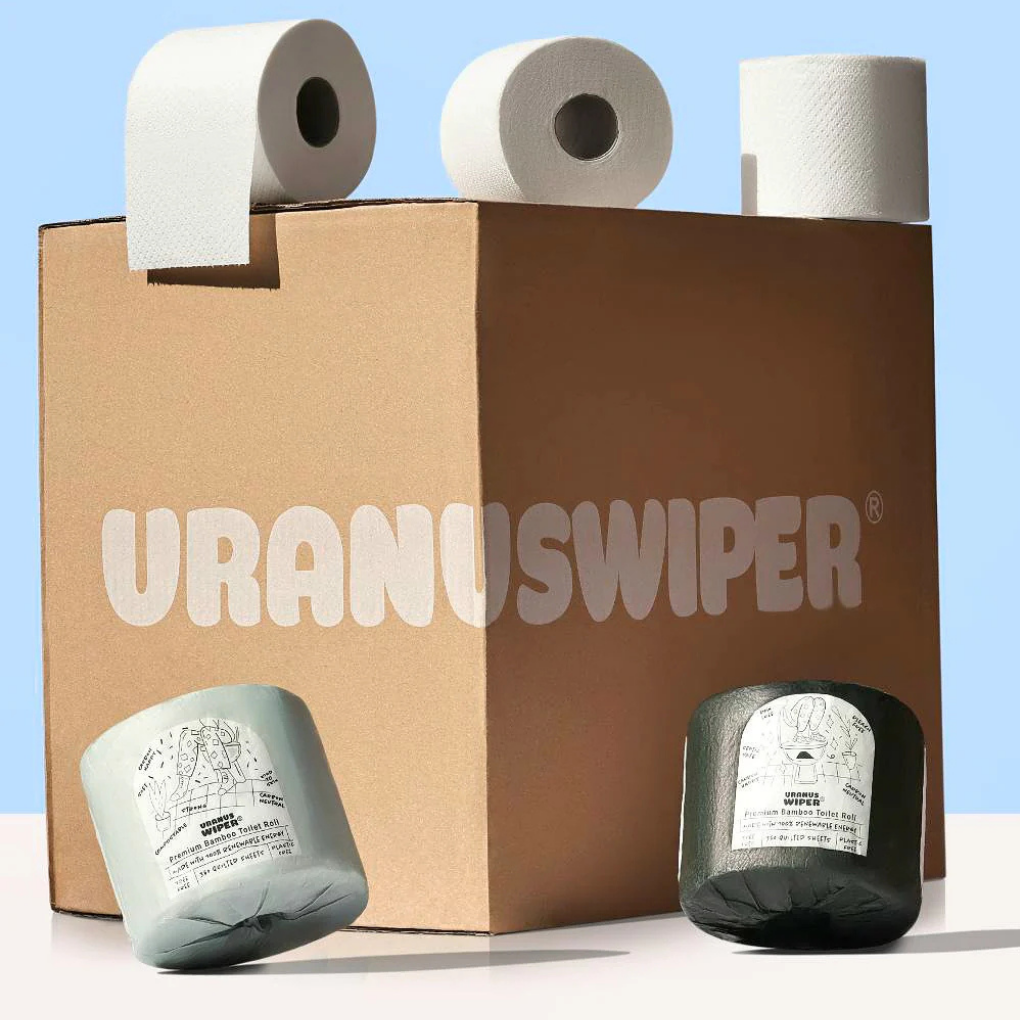
And bringing up the rear of our brand reviews is Uranus Wiper. The name might make you laugh, but the company is serious about being eco-friendly.
Their toilet paper is made from FSC-certified bamboo and produced in a carbon-neutral factory powered by renewable energy sources, including solar and biomass. Every roll comes in plastic-free, recyclable packaging, ensuring you won’t find any wasteful plastic wrap.
They also donate 1% of profits to The Anal Cancer Foundation, proving they’re not afraid to pair humor with a mission that really matters.
- Certifications: FSC® (bamboo)
Certifications and Lab Testing
With so many brands claiming to be “eco-friendly,” it can be challenging to determine which toilet paper is truly safe and sustainable. That’s where certifications and lab testing come in — they give you proof that the product lives up to its promises.
Key Certifications
- FSC (Forest Stewardship Council): This indicates that the paper or bamboo originates from responsibly managed farms and forests that adhere to sustainable harvesting practices and reforestation programs.
- TCF (Totally Chlorine Free) / ECF (Elemental Chlorine Free): These labels explain how the paper was whitened. TCF is the safest because it avoids chlorine altogether, while ECF is a step better than old-fashioned chlorine bleaching.
- Other eco-labels: Some brands take it a step further with certifications for plastic-free packaging or carbon-neutral shipping.
Why Lab Testing Matters
Certifications tell you about sourcing, but lab testing checks what’s actually in the paper. Some responsible brands share test results showing their toilet paper is free from:
- Dioxins and other chemical contamination
- Additives like PFAS, BPA, formaldehyde, or dyes
- Any hidden toxins that could cause irritation or allergic reactions
🔍 Look for: Packaging with clear certifications (like FSC® or TCF) and, if possible, brands that are open about their lab testing. Transparency is often a sign that the company genuinely cares about safety and sustainability.
How to Identify Chlorine-Free Toilet Paper
How can a toilet paper brand be truly chlorine-free? Here’s a quick shopping checklist you can use:
- Certifications: An FSC® logo means the paper or bamboo came from responsibly managed forests. TCF (Totally Chlorine Free) and ECF (Elemental Chlorine Free) tell you how the pulp was whitened.
- Packaging details: Look for words like “chlorine free,” “unbleached,” or “oxygen-whitened.” These signal safer processing methods.
- Brand transparency: Trustworthy companies clearly explain how their paper is made and may even share lab testing results.
🚩If a package only says “eco-friendly” but doesn’t give any details, it’s usually a red flag.
✨tips
How to Make the Switch
If you’re considering trying chlorine-free toilet paper, the good news is that it’s an easy swap. Here are a few tips to help with the transition.
- Order online – Many sustainable brands offer delivery with plastic-free packaging.
- Start small – Try one pack before committing to a subscription.
- Check your budget – Bamboo options can be pricier, but recycled rolls are often competitive with mainstream brands.
- Expect slight differences – Some options may look less bright white, but that’s actually a good sign of fewer chemicals.
FAQs About Chlorine-Free Toilet Paper
Chlorine-free toilet paper is made without bleaching the fibers with chlorine gas, which can create harmful byproducts. Instead, brands may use safer alternatives like oxygen, ozone, or hydrogen peroxide (Totally Chlorine Free), or chlorine dioxide (Elemental Chlorine Free). Some options are completely unbleached and keep their natural tan color.
Yes. Chlorine-free toilet paper is safe for septic systems. It breaks down in water the same way as regular toilet paper and won’t harm plumbing or septic tanks. Many eco-friendly and recycled papers are even thinner and decompose faster.
Both are good chlorine-free options. Bamboo grows quickly without heavy pesticides, making it a renewable choice. Recycled toilet paper keeps waste paper out of landfills and avoids new resource use. If softness is the priority, bamboo tends to feel smoother, while recycled paper has a smaller environmental footprint.
Chlorine-free toilet paper can be just as soft and durable as conventional brands. Bamboo-based rolls often feel silky and firm, while recycled or unbleached options may have a slightly rougher texture. Many newer eco-friendly brands are balancing softness, strength, and sustainability, so you don’t have to sacrifice comfort.
ECF (Elemental Chlorine-Free): Uses chlorine dioxide instead of chlorine gas. Safer, but still involves chlorine compounds.
PCF (Processed Chlorine-Free): Typically refers to recycled paper — no chlorine added in reprocessing, though the original fibers may have been bleached before recycling.
TCF (Totally Chlorine-Free): No chlorine compounds at all. Uses alternatives like oxygen, ozone, or hydrogen peroxide for whitening. This is the cleanest option.
Final Thoughts on Chlorine-Free Toilet Paper
At the end of the day, toilet paper might seem like a small choice, but it adds up — for both your health and the environment.
Switching to chlorine-free toilet paper is a straightforward way to eliminate unnecessary chemicals, protect your skin, and minimize your environmental impact. Whether you choose bamboo, recycled, or unbleached, you’ll be supporting better practices and healthier living.
Featured image from Amazon.
📚References
- Environmental Protection Agency. (2022). Dioxins and their effects on human health. U.S. Environmental Protection Agency. https://www.epa.gov/dioxin
- Trinh, K., & Trinh, E. (2024, November 11). How does the concentration of microplastics in recycled toilet paper compare to non-recycled toilet paper when tested in a shredded state and controlled laboratory conditions? [Preprint]. ChemRxiv. https://doi.org/10.26434/chemrxiv-2024-6ts41
